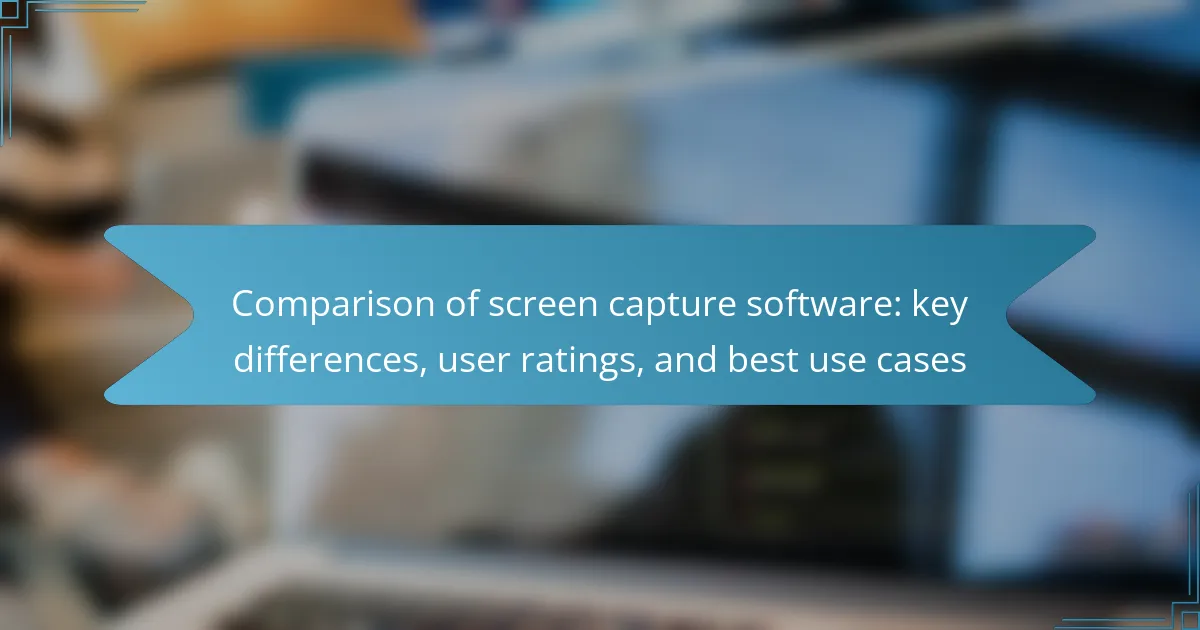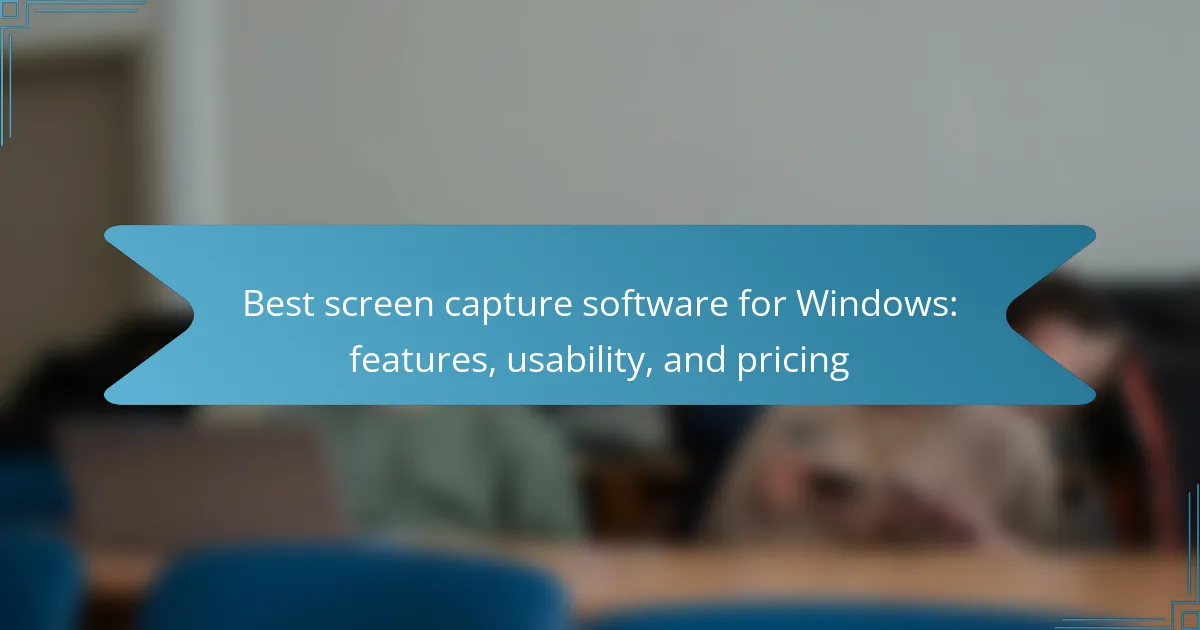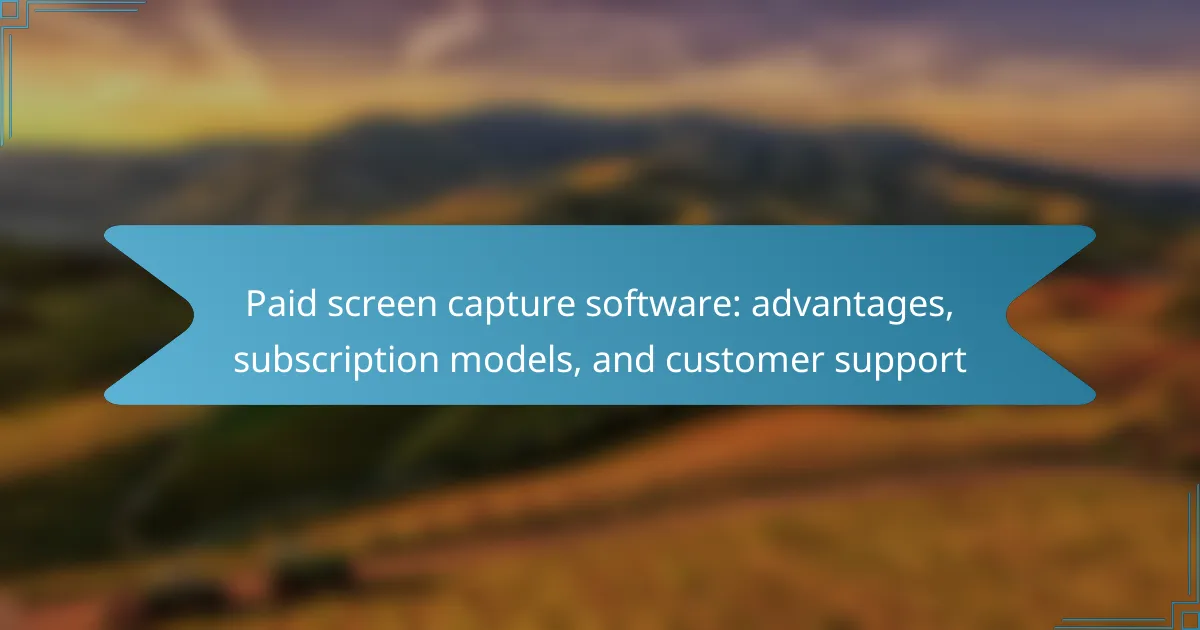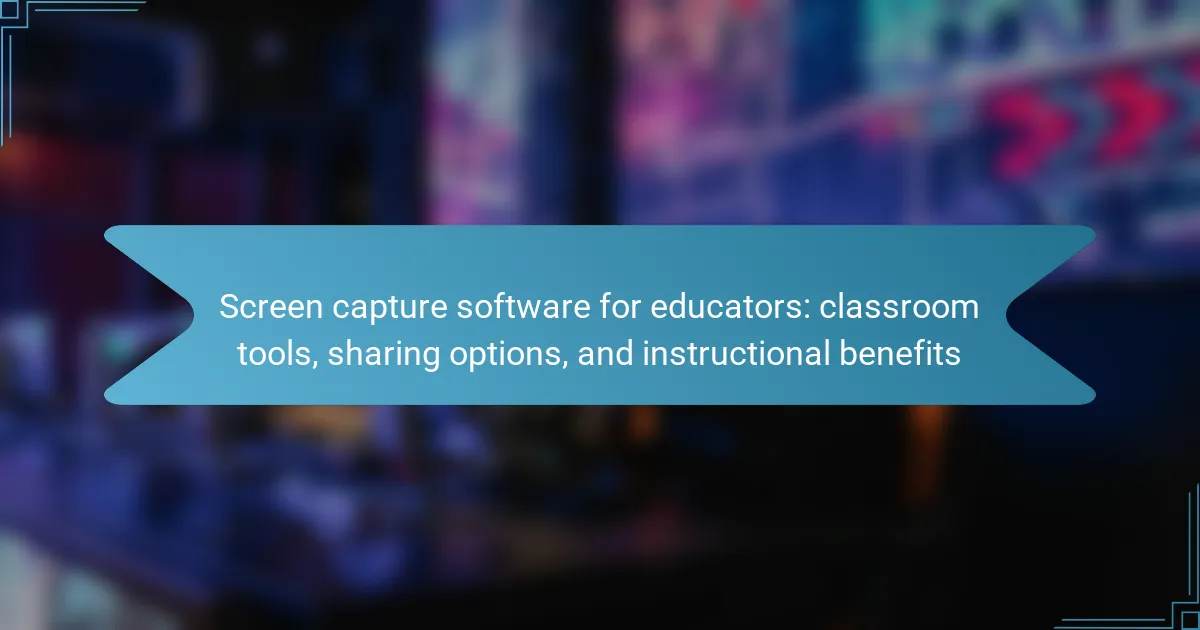Screen capture software enables users to capture and record the content displayed on their computer screens, facilitating the creation of tutorials, presentations, and visual information sharing. This article provides a comprehensive comparison of various screen capture software options, highlighting key differences, user ratings, and optimal use cases. It examines popular features such as annotation, editing capabilities, and ease of sharing, while referencing a survey indicating that 75% of users find this software beneficial for enhancing communication and collaboration. The analysis aims to guide users in selecting the most suitable screen capture tool for their specific needs.
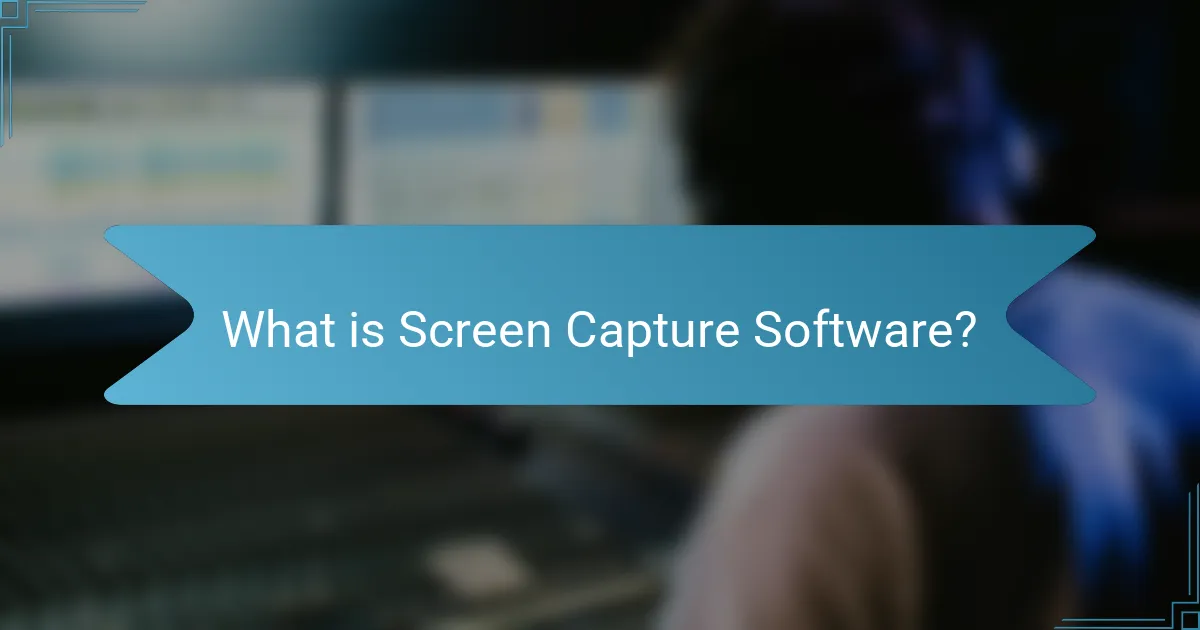
What is screen capture software?
Screen capture software is a tool that allows users to capture and record the content displayed on their computer screen. This software can capture images or videos of the screen, enabling users to create tutorials, presentations, or share information visually. Popular features often include the ability to annotate, edit, and share captured content easily. According to a survey by TechSmith, 75% of users find screen capture software useful for improving communication and collaboration.
How does screen capture software function?
Screen capture software functions by capturing the visual output displayed on a computer screen. It works by taking a snapshot or recording a video of the screen activity. This process involves accessing the graphics rendering system of the operating system. The software can capture the entire screen, specific windows, or selected areas. Most screen capture tools offer options to include audio from the system or microphone. After capturing, the software typically allows for editing and saving the output in various formats. Many programs also provide features for sharing directly through email or social media. Popular screen capture software includes tools like Snagit and OBS Studio, which are widely used for tutorials and presentations.
What are the essential features of screen capture software?
Essential features of screen capture software include the ability to capture full screen, selected regions, or specific windows. Many programs offer editing tools for annotations and highlights. Support for various file formats, such as PNG and MP4, is common. Users often benefit from customizable hotkeys for quick access. Recording audio alongside video is a valuable feature for tutorials. Cloud storage integration allows easy sharing and access. Some software provides live streaming capabilities for real-time sharing. User-friendly interfaces enhance the overall experience for both beginners and professionals.
How does screen capture software differ from screen recording?
Screen capture software and screen recording serve different purposes. Screen capture software allows users to take still images of their computer screen. This is useful for creating tutorials or capturing specific information. In contrast, screen recording captures video footage of the screen in real-time. It is ideal for creating demonstrations or live presentations. Both tools can enhance communication but cater to different needs. Screen capture typically results in a static image, while screen recording produces dynamic video content.
What are the key differences between popular screen capture software?
Key differences between popular screen capture software include features, ease of use, and pricing. Software like Snagit offers advanced editing tools, while Lightshot focuses on simplicity. OBS Studio is free and provides extensive recording options, but has a steeper learning curve. Camtasia combines screen recording with video editing, making it suitable for tutorials. Pricing varies significantly; some tools are one-time purchases, while others require subscriptions. User ratings often reflect these differences, with Snagit and Camtasia receiving high marks for functionality. In contrast, free options like OBS may rank lower due to complexity.
What criteria should be used to compare screen capture software?
Key criteria to compare screen capture software include features, ease of use, output quality, and compatibility. Features encompass recording options, editing tools, and annotation capabilities. Ease of use refers to the software’s interface and user-friendliness. Output quality involves resolution and file formats supported. Compatibility considers the software’s performance across different operating systems and devices. User reviews and ratings also provide insights into reliability and support. Price and licensing models are additional factors to evaluate overall value. These criteria ensure a comprehensive assessment of screen capture software options.
How do pricing models vary among screen capture software options?
Pricing models among screen capture software options vary significantly. Some software offers a one-time purchase model. This allows users to pay a single fee for lifetime access. Other options utilize a subscription model, requiring users to pay monthly or annually. Subscription models often include regular updates and support. Additionally, some software provides a freemium model. This allows users to access basic features for free, with premium features available for a fee. Pricing can also differ based on the number of licenses required. Bulk purchasing options may offer discounts for teams or organizations. Overall, the choice of pricing model can impact user experience and software accessibility.
What are the user ratings for various screen capture software?
User ratings for various screen capture software vary significantly. For instance, Snagit has an average rating of 4.5 out of 5 on multiple review platforms. OBS Studio typically receives ratings around 4.4 out of 5, praised for its functionality. Camtasia often scores about 4.3 out of 5, known for its editing features. ShareX averages a rating of 4.6 out of 5, appreciated for its open-source nature. Bandicam usually holds a rating of 4.2 out of 5, recognized for its user-friendly interface. These ratings reflect user satisfaction and software performance across different platforms.
Which platforms provide the most reliable user ratings?
Platforms that provide the most reliable user ratings include G2, Capterra, and Trustpilot. G2 is known for its verified user reviews, ensuring authenticity. Capterra aggregates software reviews from real users, offering insights into functionality and user experience. Trustpilot allows users to rate and review a wide range of services, enhancing transparency. These platforms utilize mechanisms to verify user identities, which increases the credibility of the ratings. Additionally, they feature algorithms to filter out fake reviews, ensuring that users see genuine feedback.
How do user ratings reflect the performance of screen capture software?
User ratings reflect the performance of screen capture software by providing direct feedback from actual users. High ratings typically indicate that the software meets user expectations in terms of features and usability. Conversely, low ratings often highlight issues such as bugs, poor interface, or lack of functionality.
For instance, a study published in the Journal of Software Engineering found that software with an average rating above 4 stars consistently outperformed those with lower ratings in user satisfaction surveys. Furthermore, user ratings can reveal patterns in performance, such as speed and reliability, which are critical for effective screen capture.
Overall, user ratings serve as a valuable metric for assessing the quality and performance of screen capture software based on real-world experiences.
What are the best use cases for screen capture software?
Screen capture software is best used for creating tutorials, recording gameplay, and conducting software demonstrations. It allows users to visually share their screens, enhancing communication and learning. For tutorials, screen capture helps in providing step-by-step instructions. In gaming, it enables players to share their experiences and strategies with others. Software demonstrations benefit by showcasing features and functionalities clearly. Additionally, screen capture is useful for capturing webinars and virtual meetings for later reference. These applications improve knowledge transfer and engagement among users.
How can screen capture software enhance remote collaboration?
Screen capture software enhances remote collaboration by enabling users to share visual information instantly. It allows team members to capture and share screenshots or screen recordings. This visual aid helps clarify complex ideas and instructions. Effective communication is improved as participants can see exactly what others are referring to. Studies show that visual content increases understanding by up to 65%. Screen capture tools can also facilitate real-time feedback during discussions. They support asynchronous collaboration by allowing team members to review shared content at their convenience. Overall, these features lead to more efficient and productive remote teamwork.
What role does screen capture software play in educational settings?
Screen capture software plays a significant role in educational settings by enhancing the learning experience. It allows educators to create visual content that can simplify complex topics. Teachers can record lectures, tutorials, or demonstrations, making them accessible for later review. This software also facilitates remote learning by enabling virtual classrooms. Students benefit from visual aids, which can improve retention and understanding. According to a study by the University of California, students who used screen capture recordings scored 15% higher on assessments. Overall, screen capture software supports diverse learning styles and promotes engagement in educational environments.
What factors influence the choice of screen capture software?
The choice of screen capture software is influenced by several key factors. These factors include ease of use, features offered, and compatibility with different operating systems. Users often prioritize software that provides a user-friendly interface. Advanced features like editing tools and cloud storage options can also sway decisions. Additionally, the software’s ability to integrate with other applications is critical for many users. Price and licensing models are important considerations as well. Performance, such as recording quality and speed, directly impacts user satisfaction. User reviews and ratings provide insights into reliability and support.
How do user needs impact the selection of screen capture software?
User needs significantly influence the selection of screen capture software. Different users require specific features based on their tasks. For instance, educators may prioritize tools with annotation capabilities. Businesses might need software that supports recording meetings and sharing files easily. Gamers often look for high-performance capture options with minimal lag.
Additionally, user experience plays a crucial role. Intuitive interfaces can lead to quicker adoption and increased productivity. Compatibility with various operating systems also affects choices. Many users prefer software that integrates seamlessly with existing tools.
User reviews and ratings provide insights into how well software meets these needs. Positive feedback often highlights features that resonate with target audiences. Research shows that 70% of users consider peer reviews before making software decisions.
In summary, user needs shape the selection process by determining essential features, usability, and overall satisfaction with the software.
What are the common challenges faced when using screen capture software?
Common challenges faced when using screen capture software include performance issues, compatibility problems, and learning curves. Performance issues may arise when software consumes excessive system resources, leading to lag. Compatibility problems can occur with different operating systems or hardware configurations. Users often experience a learning curve due to complex interfaces or features. Additionally, file size management can be challenging, as high-quality captures may result in large files. Lastly, privacy concerns may arise if sensitive information is inadvertently recorded or shared.
What tips can help users maximize their experience with screen capture software?
To maximize the experience with screen capture software, users should familiarize themselves with the software’s features. Understanding available tools enhances usability. Users should also explore keyboard shortcuts to streamline the capture process. Utilizing these shortcuts can significantly reduce the time spent navigating menus.
Adjusting capture settings is essential for optimal results. Selecting the right resolution and frame rate can improve video quality. Users should also consider using annotation tools to highlight important information during captures. This feature enhances clarity for viewers.
Regularly updating the software ensures access to the latest features and bug fixes. Keeping the software current can prevent performance issues. Users should also save captures in appropriate file formats for their intended use. Choosing the right format can impact compatibility and quality.
Finally, consulting user forums or tutorials can provide valuable insights. Engaging with the community can reveal tips and tricks that enhance the overall experience.
Screen capture software is a tool that enables users to capture and record content displayed on their computer screens, facilitating the creation of tutorials, presentations, and visual information sharing. This article compares various screen capture software options, highlighting key differences in features, user ratings, and pricing models. It discusses essential functionalities, such as editing tools and compatibility, while also exploring the best use cases for these tools in educational and professional settings. Additionally, the article addresses common challenges users face and provides tips for maximizing the effectiveness of screen capture software.
